
Are "karat" and "carat" just two different spellings for the same thing or is there a difference when it comes to fine jewelry? The answer depends on where you live.
Advertisement

Are "karat" and "carat" just two different spellings for the same thing or is there a difference when it comes to fine jewelry? The answer depends on where you live.
Advertisement
In the U.S. and some other countries, karat only measures the purity of gold: 24-karat gold is pure gold, but usually you mix gold with other metals like copper or silver to make jewelry (because pure gold is too soft). Each karat indicates 1/24 of the whole. So, if a piece of jewelry is made of metal that is 18 parts gold and 6 parts copper, that is 18-karat gold.
Where did such a funny unit of purity come from? It turns out that a German gold coin called a mark was common about a thousand years ago. It weighed 24 carats (4.8 grams). The purity of the gold in the coin was expressed in the number of carats of gold present in this 24-carat coin.
Advertisement
In the U.K., Australia and some other countries, carat can either measure gold purity or the weight of diamonds and other gemstones.
One carat equals 200 milligrams (0.2 grams or 0.007 ounce). There are 453 grams in a pound (1,000 grams to a kilogram). So, a 2 carat diamond weighs 400 milligrams.
Advertisement
The word "carat" comes from ancient Greek and means "carob seed." Carob seeds were used to measure very small gemstones, since the seeds were very light. A seed was called a carat, so a stone that weighed one seed was said to weigh a carat.
The "karat" spelling came later and should only be used when describing gold purity. Although you'll sometimes read online a phrase like a "10-karat diamond," this is incorrect. It should be a "10-carat diamond."
Advertisement
Here are some interesting links:
Advertisement
Please copy/paste the following text to properly cite this HowStuffWorks.com article:
Advertisement